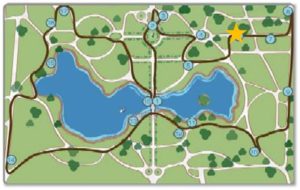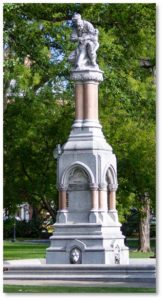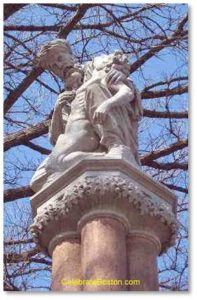Most cities don’t have one secular statue of the Good Samaritan so it’s a tad unusual that Boston has two. They are very different, however. One statue holds a prominent place in the Public Garden while the other is hidden in a medical center on the outskirts of Chinatown. Interestingly, they use the same symbol to memorialize two different things.
This week I’ll talk about the more accessible statue and fountain. Next week I’ll discuss the city’s second—and harder to find—carving.
The Ether Monument
Located in the northwest quarter of the Public Garden, the Ether Monument reminds us of the first effective use of ether as medical anesthetic and its breakthrough role in medicine.
Doctor John Collins Warren and Dentist William T.G.Morton conducted the first public demonstration of ether at Massachusetts General Hospital in 1846. (For details, see my 2014 post on The Ether Dome.) This successful use of the new anesthetic opened the door to modern surgery as it allowed doctors to work closely and carefully without the distraction of a patient suffering on the table. Ether also relieved patients of the fear of surgery—until then an excruciating procedure.
The Granite and Marble Fountain
Retired merchant Thomas Lee, Esq., funded the statue, which was designed by Boston Architect William Robert Ware and sculpted by John Quincy Adams Ward. Carved from Concord granite and polished red marble, it was raised in the Public Garden in 1868 and is the oldest statue there.
The Ether Monument stands 40 feet tall and is a fountain that pumps water from four lion heads into a square basin. The sculpture on the top depicts The Good Samaritan caring for an injured stranger he met on the road. The Samaritan holds an injured man over his knee while he tends to him with a cloth–or applies ether to relieve the man’s pain..
Four Biblical Quotations
The base of the Ether Monument holds four inscriptions of biblical quotations from Isaiah 28:29 and Revelation 21:4:
- “To commemorate that the inhaling of ether causes insensibility to pain. First proved to the world at the Mass. General Hospital in Boston, October A.D. MDCCCXLVI”
- “This also cometh forth from the Lord of Hosts which is wonderful and excellent in working.Isaiah”
- “In gratitude for the relief of human suffering by the inhaling of ether a citizen of Boston has erected this monument A.D. MDCCCLXVII”
- “Neither shall there be any more pain. Revelations”
The Ether Controversy
By using the Biblical image, the sculptor gracefully avoided dealing with the controversy of who actually discovered the medical use of ether. Two men claimed the distinction—Dr. WTG Morton and his advisor, Dr. Charles Thomas Jackson, brother-in-law of Ralph Waldo Emerson.Their competing claims resulted in a fight called the Ether Controversy.
Dr. Oliver Wendell Holmes handled the dispute diplomatically by stating that the monument was to “ether or either,” alluding to the claimants of the discovery. It was a quip worthy of Mark Twain. Mr. Twain lacked a sense of humor on this issue, however, and instead accused Dr. Morton of stealing the honor. Time heals all wounds and both men are now buried in Mt. Auburn Cemetery.
Most of the people who pass this statue regularly have no idea that the first surgical use of Ether happened in Boston, that this statue commemorates it or that the figure on the top is the Good Samaritan ministering to a stranger on the road. Maybe we could reach more people with this interesting history if a note popped up on cellphones as they drew near or it became a Pokemon stop.
Next Week: The Boston Dispensary’s Good Samaritan
Information and Directions to the Ether Monument
 The Ether Monument is located near the gate at Arlington and Marlborough streets close to the George Robert White Memorial, which was recently refurbished and repaired. Water now flows into the cobblestone basin.
The Ether Monument is located near the gate at Arlington and Marlborough streets close to the George Robert White Memorial, which was recently refurbished and repaired. Water now flows into the cobblestone basin.
You can park in the Boston Common garage nearby, as I often do when I’m giving a Back Bay Tour for Boston By Foot or attending a meeting at the @BostonByFoot office on Beacon Hill. Or take the T’s Green Line, get off at the Arlington Street station and walk north along Arlington Street. The Public Garden is always open and there is no admission fee.


